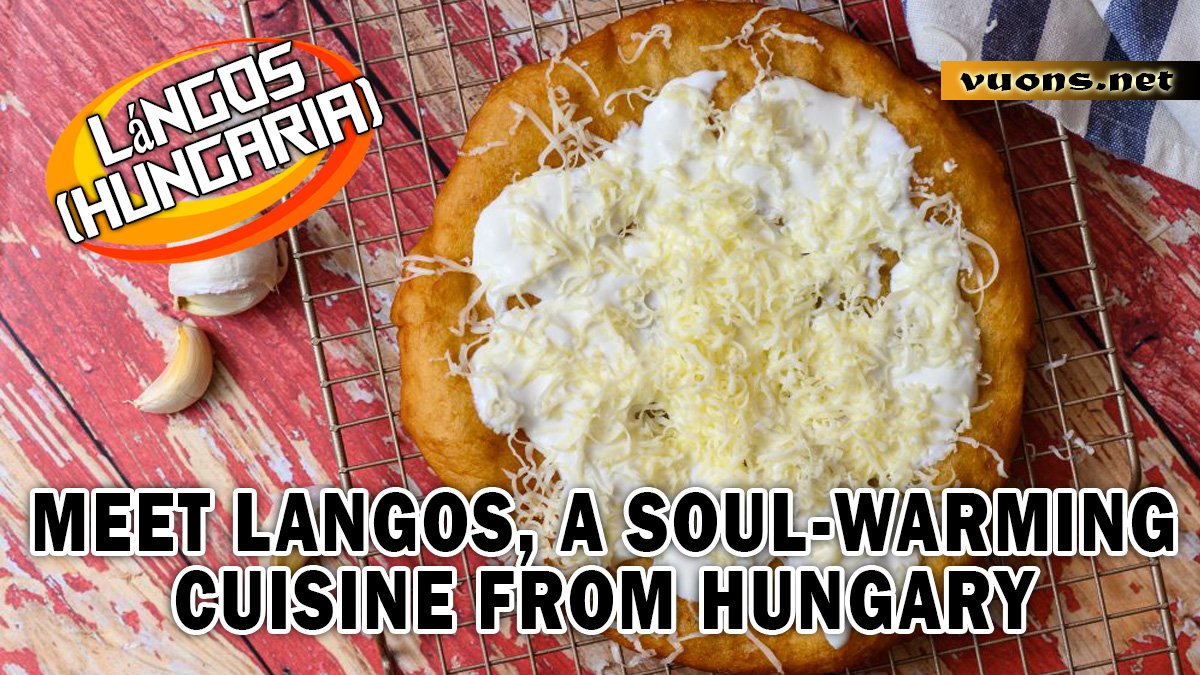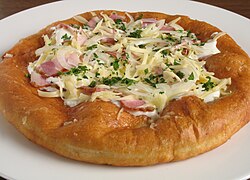From Hungary: The Global Popularity of Lángos
The Origins of Lángos: From Traditional Kitchens to World Tables
From Hungary: The Global Popularity of Lángos – Lángos has a long history rooted in traditional Hungarian kitchens. The name “lángos” comes from the word “láng,” which means “fire” in Hungarian. In the past, lángos dough was baked in a wood-fired oven before becoming the fried bread we know today. The dish is believed to have been influenced by the Culinary traditions of the Ottoman Empire, which brought the style of cooking fried bread to the Hungarian region.
The main characteristic of lángos is its soft inside and crispy outside texture. Made from wheat flour dough mixed with yeast, water, salt, and sometimes potatoes, lángos is then fried until golden brown. Classic toppings such as sour cream, grated cheese, and garlic add to the taste of lángos. Additionally, modern variations with the addition of sausage, jam, or chocolate show the flexibility of this dish to adapt to global tastes.
The popularity of lángos extends beyond Hungary’s geographical borders, especially to Central European countries such as Austria and Slovakia. At festivals, markets, and even modern restaurants, lángos has become a favorite street food. This dish reflects not only Hungarian flavors, but also the warmth of the local culture that welcomes visitors from all over the world.
Lángos Characteristics: Fried Bread with Various Delicious Toppings
Lángos is a typical Hungarian fried bread that has become an icon of street food in the country. Made from a dough made from wheat flour, yeast, water, and salt, lángos has a unique texture: crispy on the outside but soft on the inside. Sometimes, mashed potatoes are added to the dough to give it a richer taste and a soft texture.
The specialty of lángos lies in the variety of toppings that complement it. Classic toppings such as sour cream and grated cheese are favorites of many people. Meanwhile, garlic rubbed on the surface provides an appetizing aroma. For a more savory variant, some people add sausages, smoked meat, or even Hungarian paprika.
In addition to savory toppings, lángos can also be served with a sweet touch. Fruit jam, melted chocolate, or powdered sugar are often chosen to provide a different taste that is still delicious. This flexibility makes lángos popular with various groups, both children and adults.
In Hungary, lángos is usually enjoyed while still warm, right after frying. This dish is not only a favorite at markets and festivals, but also in restaurants that carry the concept of traditional cuisine. Its popularity has now spread to various countries in Europe, making lángos one of the dishes that represent the deliciousness of Hungarian culture.
How Did Lángos Become an Iconic Hungarian Dish?
Lángos has its origins in a simple Hungarian cooking tradition that uses a wood-fired oven. The word “lángos” comes from “láng,” meaning fire, referring to the early process of baking dough near a fire before it evolved into fried bread. This tradition was strengthened by the influence of the Ottoman Empire, which introduced the frying technique to Central Europe, including Hungary.
What makes lángos unique is its versatility in preparation and its authentic flavor. Made from simple ingredients like flour, yeast, water, and salt, lángos are deep-fried until golden brown. Toppings like sour cream, grated cheese, and garlic add to its appeal, making it a favorite at Hungarian markets and festivals.
In the 20th century, lángos’ popularity grew even wider when it began to be sold as a street food. It is easy to make, affordable, and filling, making it an ideal choice for people from all walks of life. Local festivals have also played a big role in popularizing lángos, making it an unmissable symbol of Hungarian cuisine.
Today, lángos is not only known in Hungary, but also in neighboring countries such as Austria, Slovakia, and Romania. Modern restaurants have even started to serve lángos with innovative new toppings to suit global tastes, ensuring that the dish remains relevant amidst the international culinary competition.
Lángos Variations Across Countries: Interesting Adaptations
Lángos, Hungary’s signature fried bread, has crossed borders and been adopted in various forms by a number of cultures. The dish originally started out as a simple dough that was fried until crispy, with classic toppings like sour cream, garlic, and grated cheese. However, each country that adopted it added its own unique local twist, creating interesting variations.
In Austria, lángos are often served at Christmas markets and winter festivals. Their version stays true to the typical Hungarian savory toppings, but with the addition of local spices like paprika powder or special sauces. In Slovakia, lángos are known by a similar name and are usually served with more garlic, giving them a strong, distinctive aroma.
Romania also has a variation called langosi, which are often filled with cottage cheese or jam before being fried. This version provides a sweet twist to the predominantly savory Hungarian dish. Meanwhile, in Serbia, lángos are often garnished with ham, mayonnaise, and pickles, offering a more complex combination of flavors.
Modern adaptations of lángos are also emerging in countries outside Europe. In the UK and US, Hungarian restaurants are serving lángos with innovative toppings such as grilled meat, BBQ sauce, or even vegan variations to cater to global tastes.
The flexibility of lángos to adapt to local ingredients and flavours makes it a street food that not only maintains tradition but also continues to be relevant on the global culinary stage.




